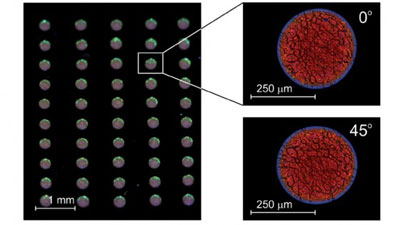
Lasers Printed via Ink-Jet
CAMBRIDGE, England, Sept. 20, 2012 — Using everyday ink-jet technology, scientists have designed a process for "printing" an organic laser on virtually any surface. The development has wide-ranging possible applications, including biomedicine and displays.
Most lasers today are made on silicon wafers similar to those used in microchips — an expensive process. But the new method, developed by researchers at the Centre for Molecular Materials for Photonics and Electronics and the Inkjet Research Centre, both in the engineering department at the University of Cambridge, uses technology similar to that used in many homes.
Their approach involves developing lasers based on chiral nematic liquid crystals (LCs), similar to the materials used in flat panel LCDs. These are a unique class of photonic materials that, under the right conditions, can be stimulated to produce laser emissions.
If aligned properly, the helix-shaped structure of the LC molecules can act as an optically resonant cavity — an essential component of any laser. After adding a fluorescent dye, the cavity can be optically excited to produce laser light.
High-quality LC lasers currently are produced by filling a thin layer of LC material between two accurately spaced glass plates one-hundredth of a millimeter wide. The glass is covered with a specially prepared polymer coating to align the LC molecules. The complex process requires a cleanroom environment and multiple, intricate production steps. Also, the range of available substrates is typically limited to glass or silicon.
The Cambridge system aligns the LC molecules and produces high-resolution multicolor laser arrays in one step, by printing them.

Images of ink-jet-printed LC laser droplets on a PVA film. (Image courtesy of Soft Matter)
"Until now, no one has been able to print lasers; the materials typically used to make lasers only work on certain surfaces and after extensive, and expensive, manufacturing processes," Cambridge team member Damian Gardiner told the BBC.
Using a custom ink-jet printing system, the researchers printed hundreds of small dots of LC materials onto a substrate covered with a wet polymer solution layer. As the solution dries, the chemical interaction and mechanical stress cause the LC molecules to align and turn the printed dots into individual lasers.
The researchers believe that this simple process can form lasers on virtually any surface, rigid or flexible, and can potentially be applied using existing printing and publishing equipment (similar to the ones used to print papers or magazines).
The process was developed initially to produce compact, tunable laser sources and high-resolution laser displays. However, it also can be used to print fluorescence tag-based lab-on-a-chip arrays used extensively in biology and medicine.
One potential use could be "smart wallpaper" in museums, team member Wen-Kai Hsiao told the BBC.
"You can produce hundreds and thousands of small lasers in one step, using technology not very different to the one you use to print letters and holiday photos at home," he said. "The lasers can be used for various display and lighting applications, or they can encode information and turn any surface into a 'smart surface.' If you print a museum wallpaper with laser dots inside, blind people who walk around the museum with a low-power scanner can this way know which room they're in, what exhibition is displayed and where they have to turn to find an emergency exit."
A UK patent application has been filed by the university's technology commercialization arm. The work was funded by the UK Engineering and Physical Sciences Research Council under the COSMOS Technology Translation and Innovation in Industrial Inkjet Technology projects.
The research appears in Soft Matter.
Read the full article at: http://pubs.rsc.org/en/Content/ArticleLanding/2012/SM/C2SM26479J
For more information, visit: http://www.cam.ac.uk/research/news/researchers-develop-printable-lasers
Published: September 2012